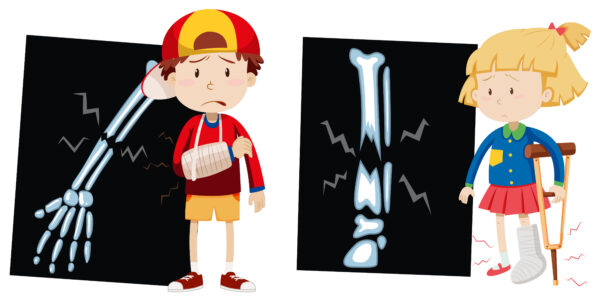What are Bone Fractures?
A fracture is a unique break or crack to bone which can take form in different ways based on the mechanism of injury and force applied. The break, or fracture, severity depends on the external force to the body which can cause the bone to crack and/or shatter.

Bone Fracture Symptoms
Fractures tend to be painful to the touch and difficult to move the affected area due to swelling, tenderness, or deformity of the targeted area. Discoloration may also be present as result to the fractured bone.
What Causes Bone Fractures?
Typically, fractures are caused by external trauma such as motor vehicle accidents, falling, or contact sports such as football. Osteoporosis may lead to decreased strength of the bones leading to potentially more fractures, especially in falling incidents when the individual tries to brace their fall with an out stretched hand. Additionally, overuse in repetitive motions can add force to the bones leading to stress fractures (more common in athletes).
Types of Fractures?
As stated above, there are multiple types of fractures that can occur based on severity and
include but are not limited to:
Stable fracture: Least severe where the broken bone lines up and is barely misaligned
Open (compound) fracture: The bone breaks through the skin and may be visible in the opened wound
Transverse fracture: A horizontal break to the bone
Oblique fracture: An angled break to the bone
Comminuted fracture: When the bone shatters into multiple parts
Avulsion fracture: A small part of the bone attached to tendon or ligament is broken off
Tuft fracture: Often caused by a crush injury and the break is at the edge of the bone at the fingers
Conservative Bone Fracture Treatments
Depending on the severity of fracture, your physician may cast the affected area with plaster or fiberglass to immobilize the fractured site. Functional casting or bracing may be used to allow limited and supported motion to nearby joints, however this method depends on the location of fracture and severity. Your physician may also try skilled traction techniques to gently realign the bone.
Exercises with your OT may address neighboring locations of fracture site while it heals as
general rule of thumb is to not begin strengthening exercises for about 8 weeks post injury or surgery.
What Does Bone Fracture Surgery Look Like?
Should the fracture prove to require surgical intervention then external fixation or open reduction and internal fixation may be required and include:
External fixation is a procedure where the surgeon places metal pins/screws directly into the bone above and below fracture site in order to properly align the bone so that it may heal in a stabilized manner. This surgery entails a metal bar is placed outside of the body which stabilizes the pins/screws on the affected bone.
Open reduction and internal fixation requires the surgeon to reposition the fracture into a typical alignment using specific screws and metal plates to the outer most surface of the bone.
Additionally, rods may be placed in the center of the bone, however this depends on the anatomical location of the fracture.
Precautions/Contraindications?
It is important to listen to your physician on general use of the affected limb and to note if there are any changes in sensation or color of skin while the fracture site heals. Do not try to over use the affected site as proper time to heal the fracture is crucial especially after the cast is removed.
It is expected that muscle strength and motion of the affected site will decrease due to general non-use while the fracture heals, so it is important to heed the guidance of your healthcare providers on gradually reintroducing the affected limb into everyday tasks based on protocols for general wound healing.
References
https://orthoinfo.aaos.org/en/diseases–conditions/fractures-broken-bones/
A little bit about Amy Eckert, our visiting OT student…







